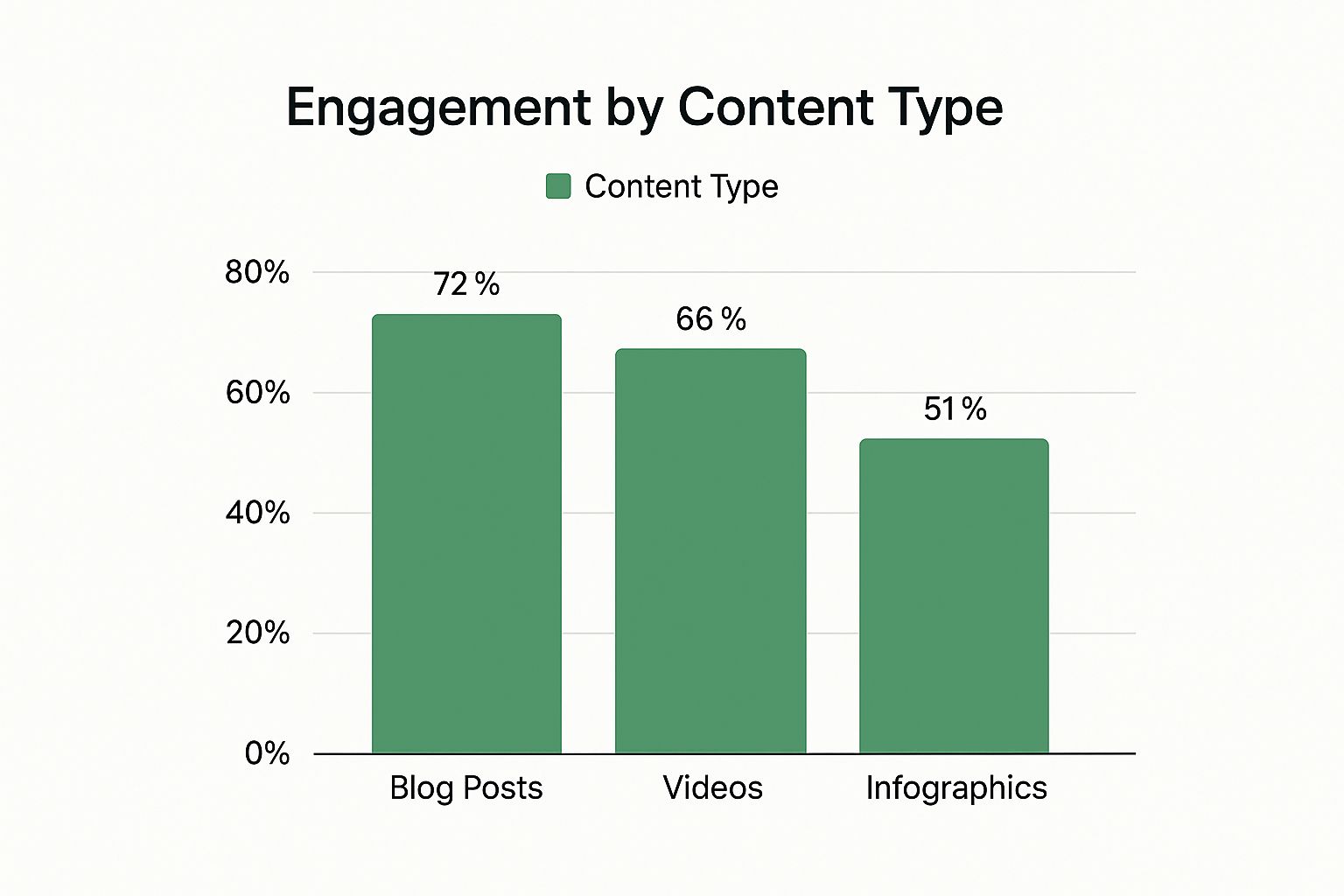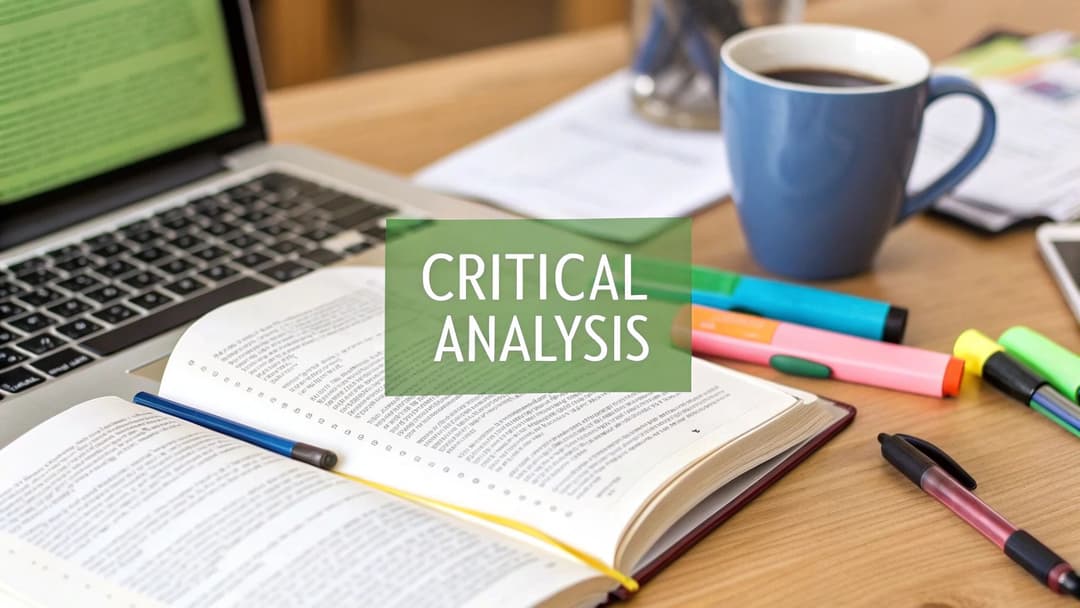
How to Write Compelling Content That Actually Resonates
June 10, 2025
Understanding Your Readers Like Real People
Let's be honest, a lot of content out there misses the mark. Why? Because it's written for some imaginary audience instead of actual, breathing humans. After years of writing, I've learned one thing: truly great content comes from truly understanding your readers. Forget the surface-level stuff; you need to dig deeper.

This chart shows how different content types perform. Blog posts (72% engagement) and videos (66%) tend to do better than infographics (51%). This tells us something important: choosing the right format matters. We'll talk more about that later. But even though infographics have lower engagement, they're still super useful for visualizing data and breaking up walls of text. They make complex info easier to digest.
Getting Inside Your Audience's Head
Say you're writing about "how to write compelling content." You think you know your audience: aspiring writers, marketers, and content creators. But have you thought about what really drives them? What are their fears? Are they worried about failing, finding their voice, or constantly coming up with new ideas?
This is where audience research becomes essential. And it doesn't have to be expensive. It's about being genuinely curious. Talk to your readers. Respond to comments. Join online communities. Listen to their frustrations and celebrate their successes. Pay attention to the language they use – the words they choose to describe their struggles and wins. This is gold for creating content that resonates.
A Real-World Example
A friend of mine, a successful food blogger, noticed something interesting. Her readers were sharing her recipes but struggling to replicate the flavors at home. She initially thought it was a skill issue. But after talking with them, she discovered the real problem: they weren't confident about finding quality ingredients. This changed everything. She started including tips on sourcing ingredients from local farmers markets, identifying fresh produce, and understanding spice profiles. The result? Her audience loved it. It built a stronger connection. Understanding your audience lets you tailor your content to their specific needs and preferences.
Compelling content is powerful. It can influence how people feel about a brand. In fact, about 82% of consumers say they have a more positive view of a brand after reading personalized content. That’s huge! It shows how important it is to create content that truly speaks to your audience. If you want to learn more about the impact of good content, check out these Content Writing Statistics.
Going Beyond What People Say
Here's a key insight: there's a big difference between what people say they want and what they actually share. Paying attention to this difference can make or break your content's success. By tuning in to these subtle cues, you can create something truly special—something people actually want to read and share. This understanding will be the foundation for all your future content.
Audience Research Methods Comparison
To help you get started with audience research, here’s a handy table comparing different approaches. It shows how much time and money they typically require, the depth of insights they provide, and the situations where each method shines.
| Research Method | Time Investment | Cost | Depth of Insights | Best Use Case |
|---|---|---|---|---|
| Online Surveys | Low to Medium | Low | Medium | Gathering broad audience preferences |
| Interviews | Medium to High | Low to Medium | High | Understanding individual motivations and pain points |
| Focus Groups | High | Medium to High | High | Exploring complex topics and group dynamics |
| Social Media Listening | Low to Medium | Low | Medium | Tracking trends and identifying audience language |
| Competitor Analysis | Low to Medium | Low | Medium | Understanding industry best practices and audience expectations |
As you can see, each method has its own strengths and weaknesses. Choosing the right approach depends on your specific needs and resources. While surveys are quick and inexpensive, interviews provide richer, more nuanced insights. Focus groups offer a deeper understanding of group dynamics, while social media listening allows you to keep your finger on the pulse of your audience’s conversations. Competitor analysis can give you a valuable perspective on industry standards and audience expectations.
Creating Headlines That Make People Stop Scrolling
Your headline is everything. It's the first impression, the velvet rope, the deciding factor between a click and a quick scroll into the digital abyss. I've spent a lot of time analyzing successful articles, and let me tell you, there's a real art to crafting headlines that not only grab attention but actually keep readers engaged. Forget the cheap clickbait tricks; we're going deep on what truly resonates.

Take a look at this BuzzSumo screenshot. It shows trending content and highlights the power of numbers, emotional hooks, and practical value in headlines. Notice how the top performers offer something specific and actionable? That's no accident.
The Psychology of a Click
Think about your own clicking habits. What makes you stop scrolling? Usually, it's a headline that sparks curiosity, offers a solution to a nagging problem, or maybe even hints at the writer's unique personality. Crafting compelling content begins with understanding your audience – their pain points, their aspirations, even their sense of humor. A headline that speaks directly to these things is gold.
Balancing Curiosity and Clarity
The magic is in the balance. You want to pique interest without being misleading. A vague headline might get an initial click, but it'll backfire if the content doesn't deliver. On the flip side, a headline that's too specific might not be enticing enough to draw clicks in the first place. Think of it like a movie trailer – a glimpse of the story without revealing the whole plot. For more writing guidance, check out our guide on professional writing tips.
Beyond Clickbait: Creating Headlines That Deliver
Clickbait might get clicks, but it erodes trust. Think of your headline as a promise. If you say "5 mind-blowing secrets to…" you better deliver five actually insightful secrets. Authenticity is key. Don't overpromise and underdeliver.
Testing and Refining Your Approach
There's no magic formula, sadly. What works for one audience might flop for another. Experiment! A/B test different headlines. Google Analytics can be a lifesaver here. Analyze which headlines get the most clicks and engagement. This constant tweaking will hone your headline-writing skills and help you create titles that both attract and satisfy your readers, which segues perfectly into the next important piece: finding your unique writing voice.
Developing Your Authentic Writing Voice

The best content out there? It feels like catching up with a good friend – someone who gets you, offers solid advice, and never talks down to you. This isn't about copying someone else's style. It's about finding your own and turning up the volume. It's about genuinely connecting with your audience and giving them something real. So how do you pull that off? Let's dive in.
Finding Your Natural Rhythm
Think about your favorite writers. What draws you to their work? Chances are, it's the sense of a real person behind the words. They have a distinct voice, a natural cadence that's all their own. Finding your own voice is like discovering that internal rhythm. It's about letting your personality peek through without taking over the whole show.
For example, I once coached a tech writer who struggled to make complex topics engaging. His writing was technically perfect, but it felt dry and impersonal. I suggested he sprinkle in his natural humor and passion for the subject. The difference was night and day. The technical details were still there, just presented with a warm, human touch.
The Balancing Act: Professional Yet Personable
Getting the right mix of professional and personable is crucial. Even in formal settings, warmth and authenticity have their place. It's not about being unprofessional, it's about being real.
Imagine yourself at a conference. You're more likely to connect with speakers who are both knowledgeable and engaging, right? The same applies to writing. You can be an expert in your field and be approachable. In fact, that combo is often what makes content truly magnetic.
Adapting Your Tone Without Losing Yourself
Your writing voice should flex depending on the situation. A blog post will naturally have a different vibe than a formal report. But the core of your voice – your perspective, your values, your unique way of phrasing things – should remain constant.
This means understanding your audience and the purpose of your writing. Are you talking to seasoned pros or total newbies? Tailoring your language to your readers is essential for creating compelling content. But it doesn't mean losing yourself in the process. You can adjust your tone and still be true to who you are. Looking to solidify your brand's voice? Check out these brand voice guidelines.
Letting Your Personality Shine (Subtly)
Now, letting your personality shine doesn't mean turning everything into a stand-up routine. It's about those small touches that make your writing feel human. A dash of humor, a relatable story, or just a warm, conversational tone can do wonders.
Finding that sweet spot takes practice. Experiment! Try weaving in personal stories or insights that connect with your topic. The goal is to let your personality peek through without stealing the spotlight. Think of it like seasoning a dish – just enough to enhance the flavor, not overwhelm it. That genuine touch is what will make your content memorable and keep readers coming back for more.
Choosing Formats That Actually Serve Your Message
You've got brilliant ideas just bursting to get out there. But how do you decide whether a blog post, a video, an infographic, or even a podcast is the right vehicle for your message? That's what we'll explore here. Picking the right format can significantly impact how your audience connects with your content.
Matching Message and Medium
Think of it this way: you wouldn’t wear a tuxedo to the beach, right? The same logic applies to content. A heartfelt personal story might flourish as a written piece, allowing readers to connect with your emotions through carefully chosen words. But a software demo? Video is the clear winner, letting you show, not just tell, how it works.
I once worked with a client launching a new software product. We started with blog posts explaining the features. Engagement was decent, but nothing special. Then we switched to short, punchy videos demonstrating the software in action. Engagement took off! The visual format simply did a better job of conveying the message. It made complex features instantly understandable and far more compelling.
Repurposing Content Across Formats
Don’t feel like you have to stick to just one format. The great thing about content creation is that you can repurpose a single idea across different mediums. That blog post on "how to write compelling content" could easily become a checklist, an infographic, or even a series of social media posts.
For example, 49% of marketers use video content to tell customers more about their products or services. Video offers a visually engaging way to convey information, making it easier for audiences to grasp complex concepts or product features. You can find more insights on content marketing statistics. This reinforces the idea that visuals can be especially helpful for explaining tricky topics. The key is to tailor your message to each format, ensuring it feels authentic. Simply copying and pasting won't do the trick.
Emerging Formats and Strategic Experimentation
The content landscape is always changing. Think short-form video on platforms like TikTok, interactive quizzes, and even augmented reality experiences. These new formats offer exciting ways to connect with your audience. Don't be afraid to experiment! Try dipping your toes into a new format without completely revamping your content strategy. See what works, what doesn't, and what you enjoy creating. This hands-on experience is invaluable for figuring out what truly resonates with your audience.
Content Formats and Industry Best Practices
To help you choose the right format for your message, let’s take a look at how different content types perform across various industries.
Content Format Performance by Industry
| Content Format | Average Engagement Rate | Production Time | Best For | Industry Performance |
|---|---|---|---|---|
| Blog Posts | Medium | Medium | In-depth explanations, thought leadership | Strong across most industries |
| Videos | High | High | Product demos, tutorials, storytelling | Excellent for visually driven industries like fashion or gaming |
| Infographics | Medium | Medium | Data visualization, simplifying complex information | Effective for data-heavy industries like finance or healthcare |
| Podcasts | Medium | Low | Interviews, discussions, building community | Growing popularity in many sectors, especially education and business |
| Social Media Posts | Varies | Low | Quick updates, engaging with followers | Essential for all industries |
This table offers a general overview. Actual performance will depend on a range of factors, including your specific audience, the quality of your content, and your overall marketing strategy. The main takeaway here? Choose formats that effectively communicate your unique message and resonate with your particular audience. This is a fundamental principle of compelling content creation.
Building Structure That Guides Readers Forward

Think of a well-designed building. You might not consciously appreciate the architecture, but it shapes your entire experience. Content is the same way. Great writing subtly guides readers, creating a smooth, enjoyable journey through ideas. Let's explore how to build that compelling structure.
Creating a Logical Flow
Imagine your content as a road trip. Each paragraph is a mile marker, leading seamlessly to the next. Avoid sudden detours that jerk readers around. Instead, use transitional phrases – think "Furthermore," "This means," or "For instance" – to link different sections. It's like having clear signposts on your road trip, making the journey smooth and enjoyable.
For example, imagine you're explaining how to bake a cake. You'd naturally start with gathering ingredients, then move to mixing, baking, and finally, frosting. Each step flows logically from the last, keeping your reader engaged.
Organizing for Skimmers and Deep Divers
We all read differently. Some of us skim, others dive deep. Your content structure needs to accommodate both. Clear headings and subheadings are key. They break content into digestible chunks, letting skimmers grab the highlights while offering deep divers a detailed roadmap.
Think bullet points and lists too. They offer visual breathing room and make information super scannable. They're like those handy pull-off points on a road trip, perfect for a quick overview or a longer rest stop.
The Rhythm of Engagement
Like a catchy tune, good content has rhythm. Vary your sentence length. Short, punchy sentences mixed with longer, more complex ones create a dynamic reading experience. It’s like changing up the tempo in a song, keeping listeners hooked.
Pacing matters too. Don’t drown readers in dense paragraphs. White space is your friend. It’s like giving your readers a chance to catch their breath and enjoy the scenery on their journey.
Introductions and Conclusions That Deliver
Your introduction is your first impression. It sets the tone and draws readers in. Think of it as a firm handshake – confident and welcoming. Make your purpose crystal clear, enticing readers to journey further.
Your conclusion, on the other hand, is the grand finale. It's your chance to leave a lasting impression. Summarize your main points, leaving readers feeling satisfied and inspired. It’s like the perfect ending to a road trip, leaving you with a sense of accomplishment and fond memories.
Practical Techniques for Effective Transitions
Seamless transitions are the glue that holds your content together. Here are a few tricks to help you connect your ideas smoothly:
Use Transitional Words and Phrases: Words like "however," "therefore," "in addition," and "for example" guide your reader, like a GPS on their journey.
Repeat Keywords: Repeating keywords or phrases creates a sense of continuity and reinforces your message. Think of it like revisiting familiar landmarks on your road trip.
Use Pronouns: Pronouns like "this," "that," "these," and "those" can link back to previous ideas, creating a clear connection between paragraphs.
Use Parallel Structure: Similar grammatical structures in consecutive sentences create a sense of rhythm and flow. It’s like driving on a smooth, well-paved road.
Mastering these techniques makes your content not just informative, but enjoyable. It's about guiding your readers on a satisfying journey, from beginning to end, making them want to explore further.
Polishing Your Draft Into Something Special
The real magic happens in the editing process. This is where a decent draft transforms into something compelling, something people actually want to read and share. I've seen countless times how a so-so piece can become truly special with a good polish. It's often underestimated, but trust me, editing is everything.
Seeing Your Work With Fresh Eyes
It's tough to be objective after pouring your heart into a draft. You're too close to it. That's why getting some distance is so important. My personal trick? I let it sit for a day or two. Then, I come back and approach it like I'm reading someone else's work. This helps me spot clunky sentences, repetitive phrases, and ideas that just don’t land.
Another great strategy is reading your draft aloud. Seriously, try it. This forces you to slow down and really pay attention to the rhythm and flow of your words. You'll be surprised how many awkward phrases and confusing sentences you catch this way. It's simple but incredibly effective.
Identifying Common Weaknesses
Even with a fresh perspective, it can be hard to know what to look for. Here are some common content killers I've noticed over the years:
Weak Introductions: Does your intro grab the reader right away? Or does it take a while to get going? A strong introduction sets the stage and makes people want to read more.
Lack of Focus: Does your piece stay true to its main idea? Or does it wander off on tangents? A focused piece keeps readers engaged and delivers on the promise of the headline.
Unclear Transitions: Do your ideas flow smoothly from one to the next? Or do they feel disconnected? Smooth transitions create a logical progression and make your writing easy to follow.
Tightening Your Prose While Keeping It Human
One of the hardest things about editing is tightening your writing without making it sound robotic. You want to be concise and personable. My advice? Cut out unnecessary words and phrases. Ditch the jargon and clichés. Use strong verbs.
For example, instead of writing "It is important to consider," just write "Consider this." It's much more direct and impactful. These small changes can make a world of difference. Remember, compelling content isn't just about good ideas—it's about how you present those ideas.
Delivering on the Promise of Your Headline
Finally, ask yourself: does your piece actually deliver on what the headline promises? If you promised "5 mind-blowing secrets," you better deliver five actually mind-blowing secrets. This is about building trust with your readers. Authenticity matters. It's how you create a strong connection with your audience and keep them coming back.
Measuring What Matters and Getting Better
Creating compelling content is like having a conversation with your audience. Think of it as an ongoing dialogue. The best writers are always tuning in, figuring out what resonates, and tweaking their approach based on the feedback they receive. It’s not about chasing vanity metrics like page views—it’s about genuine connection and understanding why certain pieces hit the mark. Then, you can use those insights to craft even better content.
Beyond Vanity Metrics: What Truly Matters
Clicks and shares are great, sure. But they only tell part of the story. Think of them as the appetizer, not the main course. True engagement goes much deeper. It means readers are spending time with your content, leaving comments, coming back for more, and ultimately, taking action. Are they subscribing to your email list? Downloading your lead magnet? Sharing their thoughts and sparking discussions? That’s where the magic happens.
For example, I once published a post about (ironically) "how to write compelling content." The traffic was decent, but the comments section was buzzing. Readers shared their struggles, asked questions, and even started conversations amongst themselves. That told me I had struck a chord.
Gathering Meaningful Feedback Beyond Analytics
Analytics dashboards like Google Analytics offer a wealth of data. But sometimes, you need to go beyond the numbers and connect with your audience directly. Direct feedback is pure gold. Run polls on social media platforms like Twitter or Facebook. Ask questions at the end of your posts. Even a simple "What did you think?" can uncover valuable insights.
Don't be shy about reaching out to your most engaged readers directly, either. Ask them what they love, what they'd like to see more of, and what's confusing or unhelpful. This type of direct feedback can be incredibly valuable for shaping your content strategy. You might also be interested in improving your writing skills with this guide.
Evolving Your Content Strategy Based on Data
Creating compelling content is an iterative process. It's about constant refinement. Analyze your most successful pieces. What do they have in common? Are there patterns in the topics, formats, or writing styles? Use this information to fine-tune your approach.
I once realized my most popular blog posts all incorporated personal anecdotes and real-world examples. It was a lightbulb moment. My audience valued authenticity and relatable content. I leaned into that, and my engagement soared.
Building a Sustainable System for Continuous Improvement
The best content creators build systems for continuous learning. They track their metrics, analyze reader feedback, and regularly review their content strategy. They’re always looking for ways to level up.
This doesn’t need to be complicated. A simple spreadsheet can work wonders for tracking key metrics and identifying trends. The key is to find a process that works for you and stick with it.
Creating truly compelling content is a journey, not a destination. By focusing on what truly resonates, gathering meaningful feedback, and constantly iterating, your content will become more compelling with every piece you publish. Refine your writing and ensure it shines with Natural Write – a free tool to polish your content.


